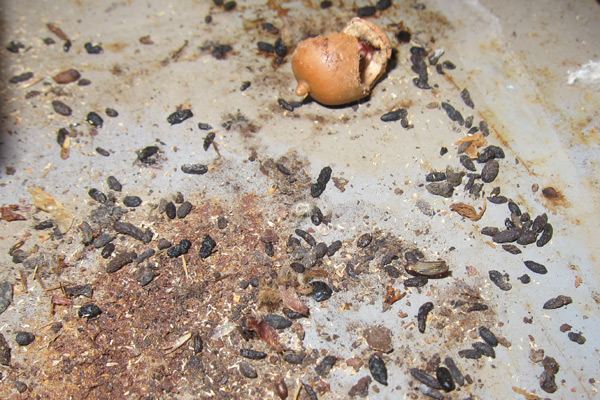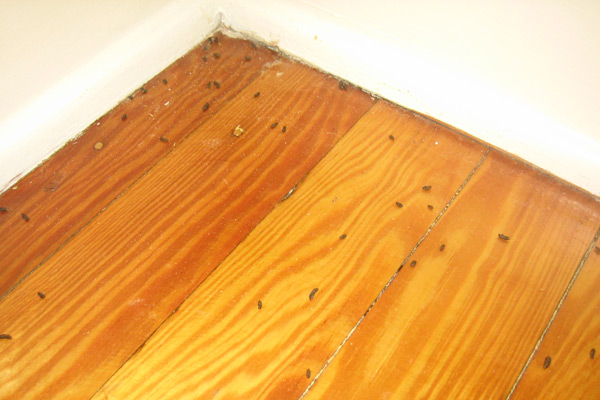- info@wildlife-removal.com
Call us for help in your town
Wildlife Removal Education
Photographs of Mouse Poop
Need mouse removal in your hometown? We service over 500 USA locations! Click here to hire us in your town and check prices - updated for year 2020.
The below photos should help you properly identify the animal poop that you
see. These are pictures of mouse poop. If you see these types droppings in
your attic or kitchen or anywhere in the house, they were made by a mouse. Go to my mouse removal page for more info on how to solve the problem or read the guide how to remove house mice.
MOUSE POOP DESCRIPTION: Skinny pellets, usually about 3/16 inch long and 1/16 inch in diameter, with pointed tips and maybe slightly bulging in the center. There is some size variance, but they are basically like
very small brown grains of rice. Fresh ones are dark brown, but they get lighter with age.

The above image of mouse feces was photographed in the garage of a house with a mouse problem. This was actually on a shelf, and you can see a small chewed acorn. Remember, this was one of those
smaller acorns, and mouse poo is pretty small. If you see larger poo, like 3/8 inch long, then that's more like rat or squirrel. I was able to identify the type of animal by inspecting the turds. Once I know what type of critter is in the house or
the crawlspace, ceiling, yard, or any other part of the property, I can take the proper steps to get rid of the unwanted rodents.
Does mouse poop cause any health risk or disease concerns? Yes, over 30 different types of disease are associated with mice and their droppings. They include the Rickettsia virus, which can create a condition similar to chicken pox.
Hantavirus is another. Eosinophilic Meningitis is another concern. The droppings of mice can cause Leptospirosis or Salmonellosis. Handle with care - that means gloves, or better yet, just sweep up and don't touch at all. And a dust mask
is a good idea too.

Mice can leave a lot of waste behind, like thousands of little mouse pellets all over the place. They dry out pretty quickly, so they are easy to sweep or vacuum, but remember, unless you solve the mouse
problem permanently, you're just going to keep getting mice poop wherever the mice travel.
I have more pics of mouse poop here on my website, or I can send some more to you if you write to me. I don't think anyone else out there has as many images of rodent poop and droppings as me - I often take photos of animal
droppings to show the customer what kind of animal they have, and so that they can decide if they need me to clean up the mouse waste, the scat and urine, and decontaminate. If you need to know how to identify mouse poop, pictures
such as the ones above are the best bet, but you can take a photograph and send it to me, and I'll tell you what kind of animal droppings you have. Read about Difference between feces of rats and mice or read What Attract House Mice?.
How do I clean up the mouse latrine? You must remove as many of the droppings as you can, by hand or vacuum, including any soiled and dirty insulation and bag it in plastic bags. Be sure to wear gloves and a HEPA respirator mask, and even a Tyvek suit. I then spray / fog the area
with a special enzyme cleaner, but any good disinfectant will suffice. Read more info on my: attic cleanup and restoration page or any of the articles I've written about mouse control methods.
What Diseases Can You Get With Mouse Dung - Whether people care to admit it or not, mice carry a lot of diseases, particularly mice that choose to invade our home and set up shops there. In answer to what can you get with mouse dung, it may almost be simpler to ask what you can’t get. First of all, the feces can carry salmonellosis, which is what we commonly call salmonella poisoning. This happens most often when their feces contaminate our food, which is a common occurrence with a mouse infestation. Often mice urinate and defecate right where they eat, making contamination very simple.
In addition to salmonellosis, you can also get Rickettsialpox, which can cause fever, rash and headaches. It is primarily transmitted through bites from the lice that live on a typical house mouse. Leptospirosis is also highly transmittable through mice feces and urine. It can cause jaundice and fever. Hantavirus is also a concern when it comes to what can you get with mouse dung. It is primarily contracted through breathing in the dust from dried feces and can even be fatal. Because of the numerous problems that can be caused by mouse dung it is not only very important that you get rid of the infestation but that you also take the time to either thoroughly clean the area yourself or to hire a professional.
Vacuum Up Mouse Feces For Increased Safety - It is often thought that the worst part about a mouse infestation is the actually animals. But the truth is, even once you are rid of the pests there can still be damaging after effects. Their feces can carry many different diseases and the older they get the more dry they become. This means that you should be very careful when you are cleaning it up. Sweeping them up with a traditional broom simply releases the dust from dried feces into the air and exposing you to any diseases and harmful bacteria that were in the droppings. For this reason a vacuum may be the better option.
There are two suggestions you should follow. First of all, make sure to wear a mask while you are cleaning up any feces left by mice and other rodents. Dried fecal matter can release harmful bacteria into the air causing illness to those that come into contact with it. When you vacuum up mouse feces you’ll want to make sure to clean the vacuum very well afterword. Throughout the bag and clean the canister along with the filter, or better yet; replace the filter. Make sure to disinfect the area with a bleach water mixture or Lysol.
Customer email about mouse poo: David, I've read all that I can find about getting rid of mice in the attic and we have tried just about all of it. Several years ago- probably at least 5 years now, I saw two house mice in our attic.
We also found hundreds of little mouse poo
pellets in our attic and in some areas of the
kitchen. We have spent several thousands of dollars with professional critter ridders including TruTech. Our carpenters gap has been sealed around the house with heavy metal. Any gaps in the crawl space have been closed or wired over. Traps have included sticky pads, Havahart wire cages, mouse and rat traps, even a good-old-boy wooden trap- a rabbit gum trap that our neighbor used very successfully to catch his
mice, etc. - our's must be smarter because we haven't caught anything. One "professional" critter company, that came highly recommended and cost the most, even fumigated the attic to run them out then claimed to have sealed everything - yeah right. They also did some damage to the house and roof. Read the guide What Are Some Humane Mouse Traps? or read Best Ways to Prevent House Mice.
We were assured by the companies, as each of the guaranteed time periods ran out, that we no longer had anything in the attic. The roof has been checked at night with the attic lights on so that openings could be seen. Just last week we had a highly qualified roofer go through the attic and the outside of the house to see if any holes can be detected. He found two holes behind the gutter and closed them. Just today, I still heard a sound in the same spot as always...there are several spots related to tracks where the insulation is patted down. We hear the sounds -
sometimes scratching - and a "plunk". The sounds occur primarily in the
night and early evening. We live in an area with lots of trees but we have had limbs and trees removed that were close to the house. I want to have additional insulation added to the attic but can't do this until I get rid of whatever is occupying the space. Any suggestions? Thanks, Carol
My response: Wow, that sounds like a tough case. Without seeing it myself, I'm not quite sure what advice to give you. But I would hold those companies that you paid a lot to, to guarantee their work, and help you out more. And they should clean the mouse droppings. Still, I don't know what your exact situation is - sounds like you still have an opening or two. You don't have a barrel tile roof, do you?
David, Thanks for your response. We tried holding the companies to their guarantees but as they ran out, the companies swore that there were no openings. I did get one company -BioLab- to refund me $500 or the several thousand that I paid because their work was shoddy. They insisted that they had to replace all of crawlspace vents which were intact. They replaced them with ones that were soon eaten through. We have since sealed the vents and conditioned the crawl space. BioLab was hard to get a hold of and took weeks to get service. The supervisor pleaded that they could not keep employees so it seemed that each new man who came was being trained. We have placed rodent feeding stations around the house just to be sure that we aren't introducing
more mice or even rats into the attic. We have never had anything within the house - just the attic
- except for a few mouse pellets found in the
kitchen cabinets but that was just one time.
This is a one story house with a crawl space and a shingled roof (3 years old) with several peaks. Also have a cathedral ceiling in the bedroom and that is one of the areas where we heard the noise
and saw mouse feces. You can't get to the area above the bedroom because of the cathedral ceiling - my husband now hates the ceiling! At one time, there was an opening in the carpenter's gap where they were clearly getting in to that area but it has been sealed for at least two years with metal. I've asked my son-in-law to help us to set up a wildlife camera in the attic to try to identify what exactly is there and where it is coming into the attic. TruTech wanted to install one of those exit traps that you show on your website but they could never find a hole to use. Tru-Tech also had trouble keeping employees but at least their employees responded within a day or two and seemed professional. Thanks anyway. We'll keep trying. Carol


















